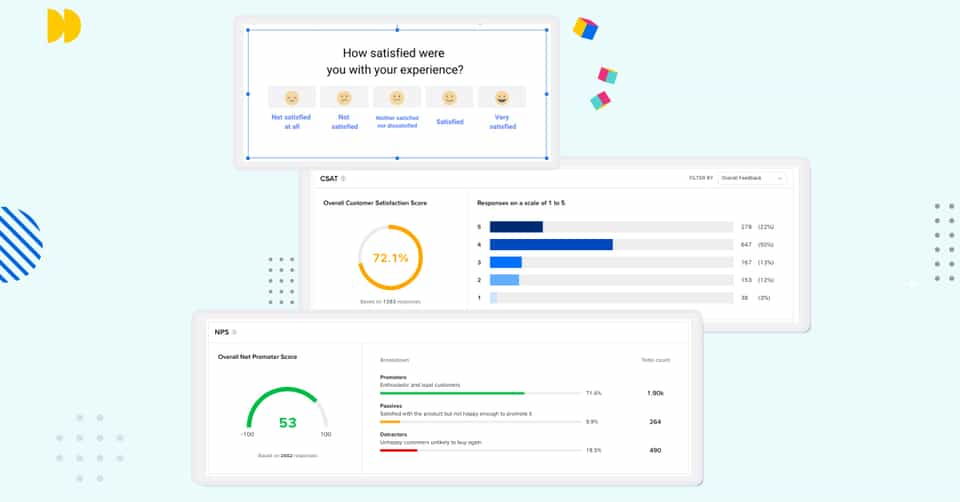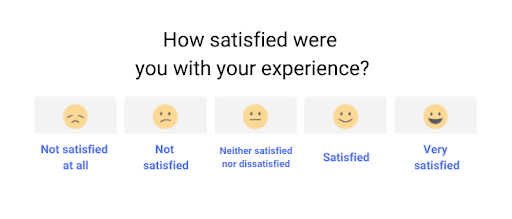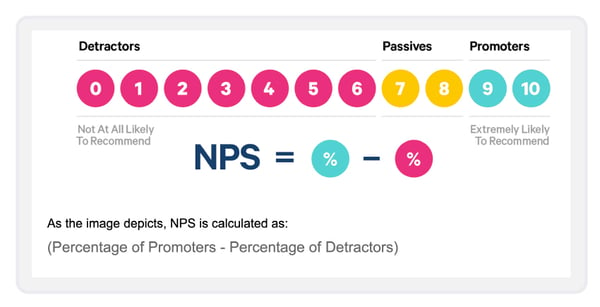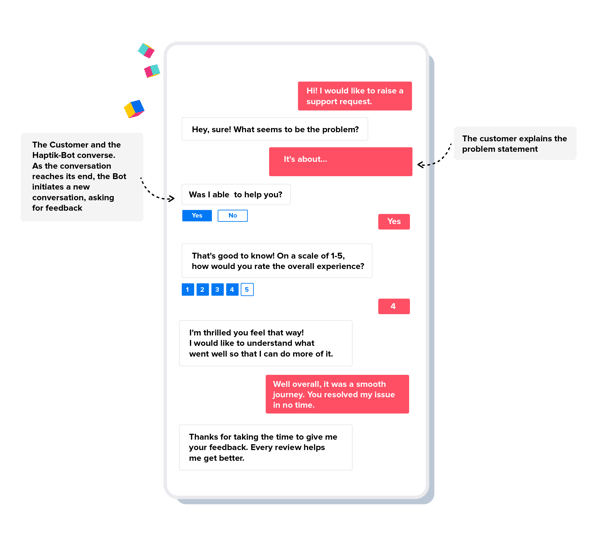How Haptik uses Conversational AI to collect NPS and CSAT

Your most unhappy customers are your greatest source of learning - Bill Gates
The ultimate goal of any business is to provide true value to its customers and the only way to ensure if we are actually achieving that goal, is by seeking answers to the following questions:
- Are our customers truly happy with our products/services and will they continue doing business with us?
- Will they recommend us to their friends, family, and colleagues?
Now, the only concrete way to get answers to these questions is by actually collecting feedback from our customers.
No matter how many automated Key Performance Indicators(KPIs) or business metrics we actively track in our dashboards, if they are not supplemented by actual customer feedback, they will never paint a complete picture.
Thus collecting customer feedback is extremely pivotal.
Especially in today’s competitive world…
Collecting customer feedback is non-negotiable.
Customer Service studies reveal that:
- Just because a business isn't receiving negative feedback doesn't always mean that customers are 100% happy.
- For every complaint that a business receives from a customer, there are approximately 26 other people who are unhappy but choose to say nothing.
- It's estimated that 91% of customers unhappy with a business will just leave without complaining.
Thus today, it's even more important to proactively seek, collect and measure customer feedback because
"It takes months to find a customer… seconds to lose one" - Vince Lombardi
But collecting Customer Feedback is NOT EASY
We are not looking to accumulate random qualitative comments. We actually want to draw valuable actionable insights from this feedback. We want to learn from them and funnel the learning back into improving our customer experience.
We thus want our Customer Feedback mechanism to be:
- Structured. It should follow a proper layout which will help us see patterns and draw insights from them.
- Measurable. We should be able to determine if we have made tangible progress by collecting and acting upon Customer Feedback.
- Repeatable. We should be able to do this process continuously. It cannot be a one-time activity.
What we need, are industry-standard techniques that will help us convert Customer Feedback into measurable metrics.
CSAT and NPS: Metrics for Measuring Customer Feedback
CSAT and NPS are the industry-standard metrics that help us collect and measure Customer Feedback.
CSAT - Customer Satisfaction
CSAT or Customer Satisfaction is measured by showcasing the end-customer a rating scale of 5 points to let them express their overall experience. It is as shown in the figure below:

Finally, CSAT will be calculated as follows:
CSAT = ((Total number of Satisfied + Total number of Very Satisfied) / Total number of responses) * 100
In other words, CSAT is nothing but the percentage of Satisfied Customers across all the customers who gave feedback.
NPS - Net Promoter Score
NPS or Net Promoter Score is measured by showcasing the customer a rating scale of 0-10 points to let them express how likely they are to recommend our company/service/product to their friends or relatives. It is as shown in the figure below:

As the image depicts, NPS is calculated as:
(Percentage of Promoters - Percentage of Detractors)
How does Haptik Collect Customer Feedback?
Haptik Chatbots use conversational AI to collect feedback from customers.
Customers always converse with Haptik Bots to get their queries and issues resolved. As the conversation draws to an end, Haptik bots initiate a new conversation. This conversation is entirely about getting feedback from the customer.
Let’s look at an example to see how it goes:

If you take a closer look at the conversational flow, the overall structure of feedback collection is as follows:
- See if the bot was helpful (Yes/No)
- Get a quantitative rating from the customer (On a scale of 1-5 or 0-10)
- Ask for a qualitative comment from the customer.
As we can see, the overall structure is very simple and straightforward. The emphasis is given to getting as much actionable feedback as possible, without trying to barrage the customer with too many questions.
But why use Conversational AI to collect Feedback? Is there an advantage?
By tradition, most applications viz chat widgets, mobile apps, websites, use a visual component to collect Customer Feedback.
These are mostly popups, takeover screens, or redirection URLs that show a visual scale for the customer to add ratings to and ask a few questions that customers are supposed to leave answers for. But this visual approach has 2 main disadvantages:
- Feedback popups or redirection URLs disturb the customer’s journey. Customers are already annoyed by popups, takeover screens, redirection URLs that keep hopping in to get their attention. Most of these feedback elements thus create a bump in the customer’s journey and thus customers today have developed a muscle memory to dismiss them reflexively. Thus feedback collection rate is often low on these elements.
- These visual elements are unable to gracefully handle customers who abandon feedback surveys mid-way. It's natural and common for Feedback Collection widgets to have multiple sections and questions on them.
Say a customer is filling out the feedback survey but concludes midway that she has had enough and it's not worth her time to continue filling out this form anymore and thus abandons it.
In such cases, whatever feedback she had given till that point where she abandoned it, will be lost. For example, the customer could have left a rating on the visual scale, or maybe even answered 1 or 2 questions before she abandoned. But since she never clicked on the “Submit Feedback” or “Done” button, none of this valuable feedback was actually registered.
However, conversational AI is capable of gracefully handling the above two scenarios:
- It does not disturb the customer’s journey. Since the customers have already been chatting with the bot to get their queries and issues resolved, when the bot asks “Was I able to help you?” at the end of their conversation, it just seems like a natural extension of the ongoing conversation. Customers, in this case, are thus more likely to stick around to give feedback.
- Customers abandoning the feedback questions midway is not a problem. Since it's a conversation, the bot would be asking questions one by one. It will not ask the next question till the first one is answered and the moment it receives a response to a question, the bot immediately registers the customer’s feedback. So, even if the customer abandons midway, the feedback collected till that point, will still be reflected in the system.
This is why Haptik decided to leverage Conversational AI rather than a fancier UI to collect Customer Feedback.
Collecting CSAT and NPS through Conversational AI
Now that we have seen Why and How Haptik uses Conversational AI to collect Customer Feedback, let us now see the conversational flow our bots follow to collect CSAT and NPS.
CSAT conversation flow
The conversational flow for CSAT is as follows:
.png?width=600&name=Artboard%203%20(2).png)
One point to note here is that whenever a customer answers the first question, “Was I able to help you?”, by saying “No”, we immediately register the CSAT rating as 1. In this case, we do not ask them to rate us separately. The reason we do this is that we firmly believe if the customer asked the bot a question to which the bot gave an answer, and then the customer says the answer was not helpful, then it is safe to assume this customer is not satisfied with the bot and hence there is no point in annoying the customer further by asking them to rate us separately. The bot is automatically rated CSAT 1 in this case.
NPS conversation flow
The conversational flow for NPS is as follows:
.png?width=600&name=Artboard%203_1%20(2).png)
Analyzing the collected CSAT and NPS feedback data
So we have seen how we can collect CSAT and NPS data through Conversational AI. The next step is to learn how can we analyze the collected data and draw actionable insight from it.
All the feedback that we collected is available in our Intelligent Analytics tool under the tab “Feedback”.
CSAT and NPS data are available under the respective tabs.
The following data is available for perusal:
- CSAT or NPS rating. The main rating is calculated after applying the respective formulas to the set of collected feedback.
Tabular view of every single feedback collected. This shows every single feedback that was registered, with details on whether the customer said the bot was helpful or not(Yes/No), the rating the customer gave, the comment (if they left any).
- Link to the actual chat. Every collected feedback is tied back to the chat this rating was given to. This is so that the bot builder can actually go through the complete customer journey to see what went wrong. In the above diagram, you can see the “View Chat” column which provides a link from each feedback to its respective chat.
- Customer’s details. Every feedback registered, is tied back to the customer who left that feedback. This helps the bot builder draw better insights and understand the customer’s pain point more deeply.
- The area within the bot to which this feedback is given. A chatbot is programmed with multiple conversational flows. A single conversational flow is termed a Skill. Multiple Skills are grouped together into Skillsets. Since there are multiple skills, if the feedback is not tied back to a particular Skill, it will be very difficult to pinpoint which areas of the bot need improvement. That is why, whenever a Customer Feedback is registered, it is automatically mapped to the Skill the said customer started their journey with.
Drawing actionable insights from the collected Customer CSAT and NPS data
We have collected CSAT and NPS. We also know all the data that is at our disposal and how to analyze it. Let us now see how we can stitch the data together to draw actionable insights from this data.
- Begin with the CSAT or NPS number. What is our CSAT or NPS presently? Is it good? Not good? From this, we get a bird’s eye view of how we are doing. This sets the tone for our further investigation.
- Pinpoint Conversation Skills within the bot that need further work. Since each feedback is automatically tied back to a particular Conversation Skill within the bot, try to see which are the most prominent areas where feedback is received. Which of our Skills is doing well? Which Skills need more work? This helps us identify the areas of our bot we need to improve.
- Go through the comments received per Skill and try to get the overall customer sentiment. The comments will help us see common patterns. Common complaints. This gives us a better understanding of what irked the customers.
- For each skill that needs improvement, start going through the chat link. Through comments, we got a high-level understanding of what the customers did not like. Now we go through the chat links to actually see what our customers were looking for and what we ended up giving them instead.
- Look at the Customer Details to grasp the overall Customer Profile. Understanding who your customers are goes a long way in getting better at serving exactly what they need. Going through Customer Details as we scan through the chat links will help us zero in on the customer and build the kind of personalization that our customers will appreciate.
How is Haptik’s Feedback mechanism distinct and superior?
Now that we have seen how Haptik’s Feedback mechanism uses Conversational AI to collect CSAT-NPS and how it gives us powerful Analytical tools to carve every corner of the collected feedback data, let us now take a step forward and see what actual benefits Haptik’s Feedback mechanism brings to us that truly sets it apart:
- High Feedback Collection Rate. Since customers have been conversing with the Haptik bot to get their queries and issues resolved, they consider the bot’s question, “Was I able to help you?”, as a natural extension of their ongoing conversation and hence are more willing to stick around and give feedback. Moreover, starting the feedback survey with a simple “Yes” or “No” question reduces the overall cognitive load on the customer.
Due to this, when compared with a traditional visual widget to collect feedback, we have seen a 3X-4X increase in feedback collection with Conversational AI. In some cases, the Feedback Collection Rate has gone from 2% to a whopping 16%.
- Omnichannel Feedback Collection. WhatsApp, Facebook, Instagram, Google Business Messages, etc. no matter which platform the bot is deployed on, Haptik’s Conversational AI-powered Feedback Mechanism can collect CSAT and NPS on it.
- Smooth hand over to Human Agents to better handle customers who faced a negative experience. For the customers who give negative feedback to the bot, the Feedback Collection Skill can be programmed to offer them an option to get in touch with a Human Agent to escalate their queries. This not only shows the customers how serious the brand is about Customer Experience, but this also gives them an opportunity to bump up their issue.
- Extremely Flexible. Since the Feedback Collection Skill is a Skill just like any other Conversational Skill within the bot, Businesses can completely mold it as per their requirements. More questions can be added, the format can be changed, etc.
- Graceful handling of abandoning customers. Since this is a conversational way of collecting Customer Feedback, the feedback flow will move in a question and answer format. Every answer received will immediately be recorded. Thus, even if a Customer abandons the Feedback Flow midway, their feedback up to that point will still be recorded and available for analysis.
Conclusion
Haptik’s Feedback Collection mechanism is not just radical with its usage of Conversational AI, but it's also extremely effective. It not only gives an excellent experience to the end consumers who will be registering their feedback through it, but it also empowers the Brands and Businesses using it, with immense flexibility and capability.
If you are intrigued by our Feedback Collection mechanism and would like to know more and experience it first hand, we would be happy to get in touch with you and walk you through it.






